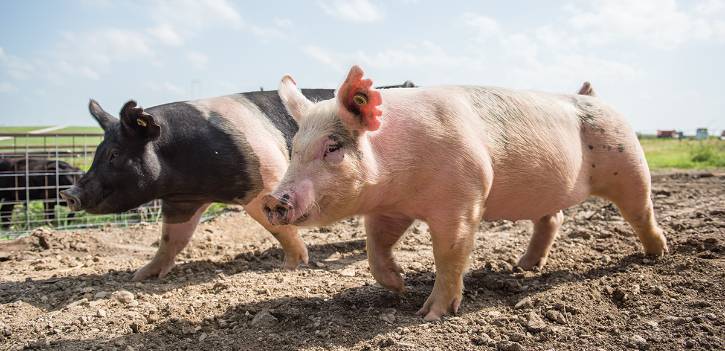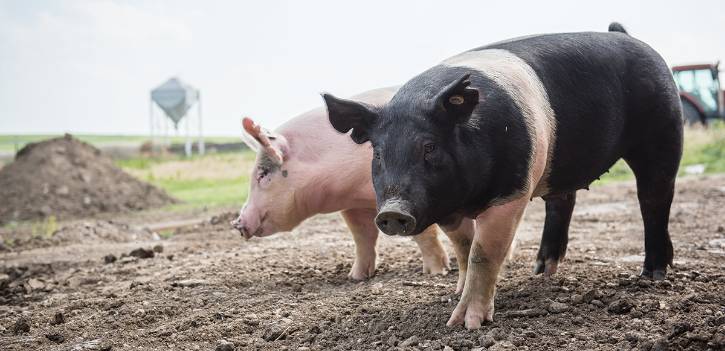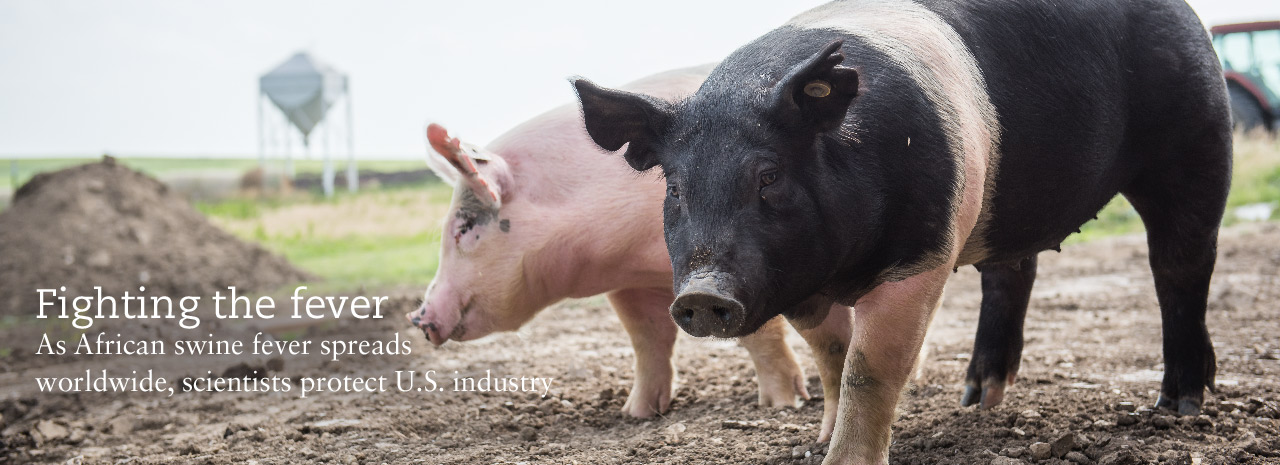Fighting the Fever: As African swine fever spreads worldwide, scientists protect U.S. industry
By Pat Melgares
The American heartland is just a little less than 11,000 miles from Beijing...a distant world away, it seems. Yet, in Manhattan, Kansas, several Kansas State University scientists focus daily on the Chinese city.
China, which once raised more than half of the world’s approximately 1.5 billion pigs, is the center of the current outbreak of African swine fever virus that has affected multiple countries in Africa, Asia and Europe, according to the World Organization for Animal Health.
The disease has never been reported in the U.S., which is the second largest country for pork production and raised approximately 70 million animals in 2019. Humans cannot contract African swine fever and pork from infected animals is safe to eat.
But for pigs, the African swine fever virus is bad news. There are no vaccines to prevent the highly contagious and deadly disease, which causes high fever, loss of appetite and other clinical signs in infected animals. Government officials have enforced strict biosecurity barriers to slow the spread of the virus.
“We compare African swine fever to lava,” said Cassie Jones, associate professor of animal sciences and industry in the College of Agriculture and a swine nutritionist with K-State Research and Extension. “There are some pathogens that are more like a volcano, where there is just an explosion of virus. African swine fever is more like the flow of lava, where it is a slow flow of disease, but you can’t stop it. It seems like no matter what we do in the countries that have been struggling with it, as soon as a herd gets contaminated or infected, it just continues to slowly spread. It’s very difficult to contain.”
China’s losses since the virus was first detected in August 2018 have topped $50 billion, according to estimates from the Food and Agriculture Organization of the United Nations. High estimates claim that 50% of the pigs in that country have been lost, which is one-fourth of all pigs in the world.
“When you think about the world’s largest pork producer losing that many pigs, it significantly changes the global swine industry because China is now going to have to replace the pork that they are no longer able to produce,” said Megan Niederwerder, assistant professor of diagnostic medicine and pathobiology in the College of Veterinary Medicine.
In the U.S., the K-State Biosecurity Research Institute, or BRI, is the only university laboratory where researchers can study African swine fever virus, which is a biosafety level-3 pathogen. A significant amount of work with African swine fever also is being done at the Plum Island Animal Disease Center in New York. The center will be replaced by the National Bio and Agro-Defense Facility, which is under construction adjacent to the K-State Manhattan campus.
The K-State research, which includes partnerships with other universities and private industry, involves experts who study the traits of the virus, the host’s immune system, potential vaccines, animal husbandry, international trade, movement of materials associated with the virus and more. Research takes place both in countries where African swine fever is present and in the safe research space at the BRI.
“In order to control most viruses, you need a multipronged approach,” said Jürgen A. Richt, Regents distinguished professor in the College of Veterinary Medicine. “This is also the basis for all of these foreign or transboundary animal diseases. It doesn’t matter whether it’s African swine fever, classical swine fever, foot-and-mouth disease, Rift Valley fever or others.”
Safe and effective

Through industry partnerships, K-State scientists are conducting African swine fever virus vaccine development work. One project involves a sponsored research agreement facilitated by K-State Innovation Partners and MEDIAN Diagnostics Inc., or MDx, a veterinary medicine company based in South Korea.
“The technology we are utilizing is based on a novel adenovirus backbone — developed from human adenovirus serotype 6 — that can amplify a transgene up to 10,000 copies in the infected cell without producing infectious viruses,” said Waithaka Mwangi, professor of diagnostic medicine and pathobiology in the College of Veterinary Medicine.
Mwangi said that the single-cycle adenovirus vaccine platform can safely induce more robust and persistent immune responses compared to live, inactivated and subunit vaccines that are traditionally used. This platform was originally developed at the Mayo Clinic. “We believe this will be a way to deliver a safe and effective vaccine,” Mwangi said.
Feed and fever
Niederwerder focuses on ways that foreign animal diseases, such as African swine fever, could be introduced through feed and feed ingredients. Swine feed often consists of many ingredients, such as amino acids, vitamins, vegetable proteins or grains, to give the pig the nutrition it needs.
“One of the first parts of our work was to discover if the virus is stable in feed and feed ingredients that have been subjected to fluctuating humidity and temperature conditions during shipment,” Niederwerder said. “The U.S. imports millions of kilograms of feed ingredients from countries that may have circulating foreign animal disease. These ingredients are incorporated into swine diets, provided to pigs for consumption and could potentially serve as a route for the spread of transboundary animal disease.”
One major finding indicated that the African swine fever virus can indeed survive the boat ride across an ocean, where it could be introduced into feed provided to animals. The bottom line: This virus is stable enough to survive a simulated transport from Beijing to Des Moines, Iowa.
“That’s not a big surprise to us, but what we want to know now is if a virus makes its way into a contaminated ingredient, does that get distributed through an entire batch of feed and through the entire feed manufacturing environment, or does it tend to stay in pockets of contamination?” Jones said. “Knowing that has some really meaningful implications of whether the entire feed supply chain is contaminated, or if we have a risk area, and how careful we need to be about biosecurity and subsequent uses of equipment or trucks.”
Researchers also are working on methods to decontaminate and clean infected feed. Niederwerder has conducted a study that indicates that the half-life of African swine fever — or the amount of time it takes for the virus to decay by one-half — is between 9.6 and 14.2 days.
“Defining the timeline for how a virus decays naturally in feed allows us to consider storage periods for feed ingredients after they arrive to the U.S. from high-risk countries,” Niederwerder said.
That information also could help researchers establish guidelines for using thermal treatments or antiviral chemical mitigants, she said.
Diagnostics and vaccines

Richt’s work includes developing tools to diagnose the disease quickly as well as developing vaccines.
“The earlier you diagnose a foreign animal disease, the earlier you can stop its spread,” he said. “If you can detect the disease 24 hours earlier, how many animals can you save? How many millions of dollars can you save?”
For African swine fever, Richt’s group has partnered with Silver Lake Research Corp. of Azusa, California, to develop a point-of-care diagnostic test that is the first of its kind in the U.S. The test, called PenCheck, can be used right in the field with a simple drop of blood from a pig.
“It’s very simple, very fast and very accurate,” Richt said.
The test was developed and tested in the BRI and it is being validated by the Food and Agriculture Organization of the United Nations. Many other tests to increase the speed of diagnosis are underway, but are not yet ready for market, he said.
It will take a while to develop vaccines to provide immunity to pigs, Richt said. The first licensed vaccine for African swine fever may not be available for another three to five years.
“We do not know a lot about the basic functions and replication strategies, or the immunosuppressive functions of this virus,” he said. “When we talk about African swine fever, we often compare it to classical swine fever and foot-and-mouth disease. The genome of the African swine fever virus is 15 to 20 times the size of those agents. Also, the African swine fever virus expresses more than 150 viral genes, but we only know about 30 of those in detail, or about 20%. So, right now this virus is very effective in undermining the immune system of pigs.”
The K-State researchers agree: Collaboration is key to fighting African swine fever and other devastating diseases worldwide.
“Worldwide, we’re already having big conversations in agriculture about how we are going to feed 9.8 billion people by the year 2050,” Niederwerder said. “These diseases significantly impact the health of food-producing animals and our ability to provide protein for humans.”

